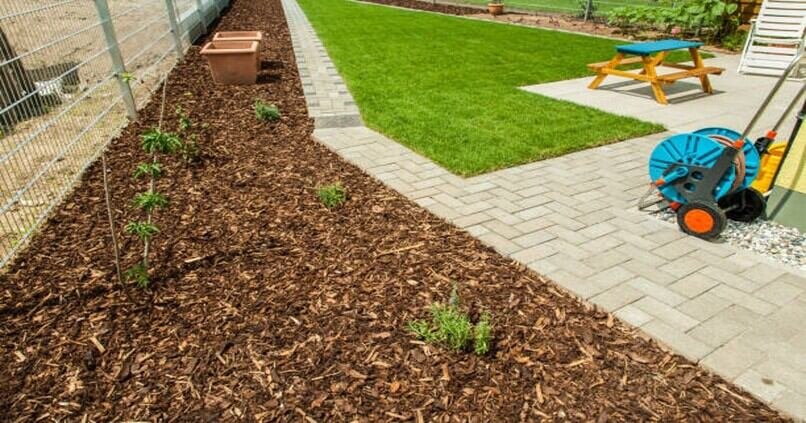Whether you’re looking to enhance the aesthetics of your outdoor space, improve soil health, retain moisture, or suppress weeds, mulching is the answer! In this blog post, we’ll delve into the process of mulching step by step and explore its numerous benefits.
So grab your gardening gloves and let’s get started on creating a beautiful and healthy landscape with the help of mulch!
Benefits of mulching
Mulching offers a multitude of benefits for your garden and landscape. Not only does it enhance the visual appeal of your outdoor space, but it also plays a crucial role in maintaining soil health and promoting plant growth.
One key benefit of mulching is its ability to retain moisture in the soil, reducing the need for frequent watering during hot summer months. This helps plants stay hydrated and thrive even in periods of drought.
Additionally, mulch acts as a natural insulator, regulating soil temperatures by keeping it cool in the summer and warm in the winter. This creates an optimal environment for root development and overall plant health.
Moreover, mulch suppresses weed growth by blocking out sunlight and preventing weed seeds from germinating. This not only saves you time on weeding but also reduces competition for nutrients among plants.
Incorporating mulching into your landscaping routine can lead to healthier plants, reduced maintenance requirements, and a more beautiful outdoor space.
Types of mulch and their uses
When it comes to mulching, there are various types of mulch available, each with its unique characteristics and uses.
- Organic mulches like wood chips, pine straw, and compost are popular for their ability to improve soil quality as they decompose over time.
- Inorganic mulches such as rocks or rubber provide long-lasting weed control and insulation benefits. Mulch made from recycled materials like shredded tires or newspapers offers an eco-friendly alternative while still providing weed suppression.
- Mulches like cocoa bean hulls add a pleasant scent to your garden while improving moisture retention. Leaf mold is an excellent choice for adding nutrients back into the soil as it breaks down slowly.
Choosing the right type of mulch depends on your specific needs – whether you’re looking for aesthetics, weed prevention, moisture retention, or soil improvement.
Important Read: How To Mulch Your Lawn The Right Way?
Preparing the area for mulching
Before you start mulching, it’s essential to prepare the area properly to ensure the best results. Begin by clearing any debris, weeds, or existing mulch from the area where you plan to lay down new mulch. This will help prevent weed growth and allow the fresh layer of mulch to have direct contact with the soil.
Next, make sure the soil is adequately moist but not overly wet before applying mulch. Watering the area a day or two before can help create an ideal environment for your plants’ roots and aid in better moisture retention.
Consider edging around flower beds or garden areas to create a clean border between your lawn and the mulched area – this not only enhances aesthetics but also helps contain the mulch within designated spaces.
Assess if any amendments like compost or fertilizer are needed based on your specific plant requirements. Taking these steps will set a solid foundation for successful mulching that promotes healthy plant growth and minimizes maintenance needs moving forward.
Step-by-step process of mulching
When it comes to mulching your garden or landscape, following a step-by-step process can help ensure the job is done effectively.
- First, start by preparing the area where you’ll be applying the mulch. This involves removing any existing weeds, debris, and old mulch.
- Next, choose the type of mulch that best suits your needs and preferences. Whether it’s organic materials like wood chips or inorganic options like rubber mulch, make sure it aligns with your landscaping goals.
- Once you have your chosen mulch ready, evenly spread it over the prepared area using a rake or shovel. Be careful not to pile it too high around plants as this can lead to issues like root rot.
- After spreading the mulch, gently pat it down to ensure good contact with the soil below. This helps with moisture retention and weed suppression.
- Water the newly mulched area thoroughly to help settle the material in place and activate its benefits for your garden or landscape.
Caring for your mulch
Caring for your mulch is essential to maintain its effectiveness in your garden or landscape. One crucial aspect of mulch care is monitoring its thickness regularly. Over time, mulch can break down and decompose, so topping it up when needed will help retain moisture and suppress weed growth.
Another important step in caring for your mulch is to keep it well-aerated by occasionally fluffing or turning it over. This helps prevent mold or mildew from developing, keeping your plants healthy and happy.
Additionally, be mindful of any weeds that may sprout through the mulch layer. Regularly removing these intruders will ensure they don’t compete with your plants for nutrients and water.
Consider applying a fresh layer of mulch annually to rejuvenate its appearance and benefits. By following these simple maintenance steps, you can enjoy the full advantages of using mulch in your landscaping endeavors!
FAQs About Mulching
Q: What are the benefits of mulching?
A: Mulching helps retain moisture, suppress weeds, regulate soil temperature, and enhance the overall aesthetics of your garden.
Q: Which type of mulch should I use?
A: There are various options like organic (bark chips, compost) and inorganic (stone, rubber). Choose based on your specific needs and preferences.
Q: How often should I remulch my garden?
A: It’s recommended to refresh your mulch once a year to maintain its effectiveness. However, it can vary depending on factors like weather conditions and the type of mulch used.
Q: Can I mix different types of mulch?
A: While it’s possible to mix different types for aesthetic purposes, be cautious as certain combinations may affect plant health or water retention differently.
Q. Got more questions?
Feel free to reach out to Soil and Seed Landscaping for personalized advice tailored to your gardening needs!
Conclusion
Incorporating mulching into your landscaping routine offers a range of benefits, from improving soil quality to enhancing the aesthetics of your outdoor space. By selecting the right type of mulch, properly preparing the area, and following a systematic process for application, you can enjoy all that mulching has to offer.
Care for your mulch by monitoring moisture levels and addressing any weed growth promptly. Avoid common mistakes like over-mulching or using inappropriate materials that could harm your plants.
If you’re looking for professional assistance with mulch installation in Clarence, consider reaching out to Soil and Seed Landscaping for their expert mulch service. With our experience and expertise in mulch blowing services in Clarence NY, we can help you achieve a beautifully landscaped yard with the benefits of proper mulching techniques.
Start taking care of your garden today for lasting beauty tomorrow!




